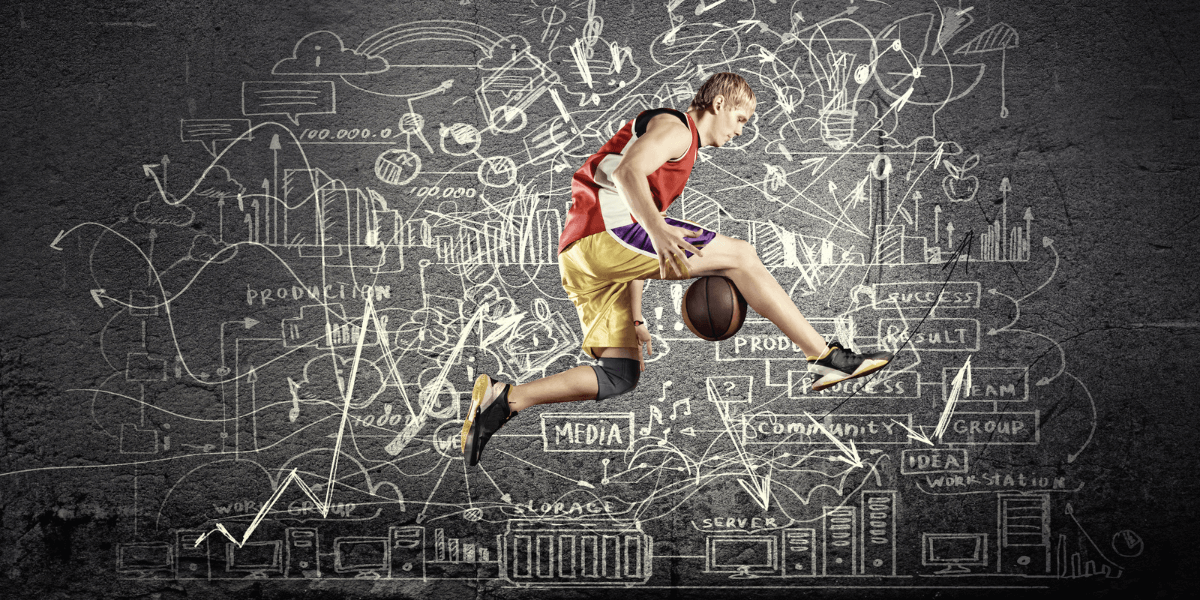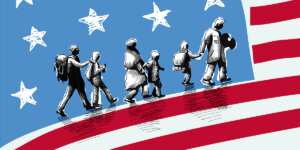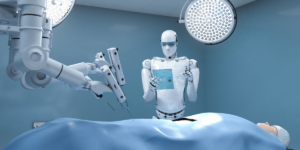
Photo Credit: Sergey Nivens/Getty Images
1. Lead NBA Teams to the Championships
Have you ever found yourself watching a Lakers’ game and thinking, “what are the odds LeBron’s gonna make this shot?”
Now, thanks to Yu-Han Chang and Rajiv Maheswaran, you can actually find out! The two former computer scientists at USC’s Information Sciences Institute (ISI) took on the challenge of quantifying the game of basketball.
They used camera data and machine learning to analyze NBA rebounding in their 2012 and 2014 studies, both of which won “Best Paper” at the prestigious MIT Sloan Sports Analytics Conference. In 2013, the team received top honors and $50,000 at the USC Viterbi School of Engineering Maseeh Entrepreneurship Prize Competition — an engineering business plan contest to help USC Viterbi students, faculty and others take their innovative ideas from the university to the marketplace.
And to the marketplace they went! What began as award-winning research papers and business plan, has become the premier company for sports AI, player tracking, analytics, and data visualization services – Second Spectrum. Co-founded by Chang, Maheswaran and Jeff Su, Second Spectrum builds systems that can see sports through the eyes of a professional coach, extract insights from tracking data that go beyond what a human can observe, and provide tools for coaches, players, leagues and media to make use of the analysis.
Maheswaran said, “From the simplest things like quickly accessing all of a player’s shots and passes in a game, to identifying deep strategic insights, we are just starting to scratch the surface of what is possible.”
And professional sports leagues have taken note! Second Spectrum, the dominant sports analytics company for the NBA, Major League Soccer and English Premier League (soccer), was acquired in 2021 by Genius Sports.
2. Curb Sex Trafficking with the NYPD
According to the most recent report on modern slavery from the International Labour Organization, 4.8 million people worldwide – almost exclusively female – were victims of sex trafficking in 2016.
And data shows that the large majority of it starts online.
Since 2013, ISI researchers have been combating sex trafficking using knowledge graphs and artificial intelligence to analyze the online footprint of this shadowy and brutal business. Research Assistant Professor Mayank Kejriwal and his team, which included Craig Knoblock, the Michael Keston Executive Director at ISI, developed a system that searched online sex advertisements for key words, phrases and activity to indicate the likely presence of a sex trafficking operation. Their work was later deployed by the New York Police Department (NYPD) and over 200 law enforcement agencies.
“Our research made quite a bit of an impact,” said Kejriwal. “Trafficking victims were rescued and traffickers were prosecuted with evidence coming from our system.” Since then, he has used his work in the field of network science to model the underground trafficking networks, paving the way for future research and policy change.
3. Translate the Bible Into Languages You’ve Never Heard Of
Joel Mathew, an ISI research engineer, grew up in India with parents involved in Bible translation.
“There were a lot of areas where I felt software technology could really speed up, improve, support and help them,” Mathew said. “It’s one of my passions to see the Bible translated in all languages.”
ISI was the main reason he joined USC in 2015 — because of its strong natural language processing group and its work on low-resource machine translation. Once at ISI, Mathew met senior research scientist Ulf Hermjakob in the AI division. It was a match made in heaven, as they were both passionate about their Christian faith and interested in low-resource machine translation.
Hermjakob explained, “People don’t realize that there are about 7100 languages in the world. Google Translate covers about 100 of them.” He continued, “For this Bible translation, we’re really targeting very low-resource languages that are not even in the top 500.”
The pair has begun the ambitious research project that uses a novel tool to match words from an uncommon language with words of a more common language. Their goal is to ultimately support human translators of any language with spell-check, word and phrase selection, and identification of inaccuracies to ensure accurate, consistent and time-efficient translation.
4. Warn Texans About Deadly Flash Floods
In the Dallas-Fort Worth (DFW) metroplex in North Texas, flash flooding kills more people annually than any other type of severe weather.
Since 2008, NOAA (National Oceanic and Atmospheric Administration) and the National Weather Service have used a flash flood forecasting system in DFW that incorporates parameters such as soil moisture and temperature, permeability, vegetation and the driving factor: rainfall.
Over the years, these inputs have increased in accuracy and volume, leading to a problem: too much data!
Enter Pegasus – a workflow management system created by ISI research professor Ewa Deelman and her team at ISI, that enables collaborators from University of Massachusetts at Amherst and University of Texas Arlington to handle these large amounts of data.
With Pegasus, two sources of precipitation data are fed into the model, along with a multitude of input parameters. The model outputs streamflow, runoff, and time frame estimates valuable for flash flood forecasting. Additionally, and importantly, it then allows for results to be mapped.
When areas on the map exceed set thresholds, it triggers targeted flash flood alerts sent to people in the risk area, as well as city emergency managers and stormwater management personnel. With the help of ISI researchers, the flash flood forecasting system in DSW is now faster, more accurate and better at saving lives.
5. Help You Find Your Next Job
Are you seeing all the job ads you should be seeing?
For certain races and genders, unfortunately the answer might be no. According to U.S. law, job ads may be targeted based on qualifications, but not on protected classes such as gender or race. However, multiple studies have shown that ad delivery on social network platforms such as Facebook, Google and LinkedIn can be skewed by gender or race due to content ranking algorithms.
A team at ISI has developed a method for identifying illegal skew by gender, while protecting the privacy of the users and the algorithms of the platform.
“These platforms invest millions of dollars in building the best algorithms, so they will not share their source code,” said USC research professor John Heidemann. This research, conducted by Heidemann, Aleksandra Korolova and Baslieal Imana, paves the way for external audits for protected class bias – which may be enforced by federal law sometime in the future, as legislation to that effect has already been proposed.
6. Calculate Artistic Style
What makes Mona Lisa’s smile so mysterious?
Someday, we might have a quantitative answer to that thanks to the advancements being made in visual stylometry, a field that uses methods from computer science – think: AI and machine learning – art history and cognitive science to quantify artistic style.
Former ISIer Ricky J. Sethi recognized a need in the field.
For the people most interested in the analysis of a piece of artwork – students, scholars, and artists themselves – the visual stylometry programs and findings were inaccessible, so he and his team created WAIVS (Workflows for Analysis of Images and Visual Stylometry). They used a platform Sethi worked on when he was at ISI, a tool developed by ISI principal scientist Yolanda Gil. It’s a platform for computational experiments that includes an AI component to help non-experts understand the experiments. Sethi said, “We’re customizing this existing tool for humanities and art researchers.”
Unsurprisingly, there are many interested parties in this project. Psychologists are using it to try to decrypt what aspects of artwork trigger our psychological reactions. Students and lay people are using it to understand artwork and categorize schools of art and artists.
“And many researchers,” said Sethi, “are focusing on the question: ‘can we actually quantify and come up with a mathematical representation of artistic style?’”
7. Get Salad on the Menu
“Poor diet is the leading cause of all cardiovascular diseases and thus mortality worldwide,” said Abigail Horn, a research assistant professor at ISI. “So anything we can do to improve diet will have a big impact on public health.”
Horn and her team have set out to make such an impact with their current research on fast food restaurants. The team has found that people’s food environments – the type of food or restaurants they have access to – can impact their diets. And it’s not just the food available around their homes, but also the food outlets they encounter during their day, which the team can access through cell phone mobility data. The researchers linked that information with health data to show that food environment is strongly correlated to diet-related diseases. The research goes a step further, analyzing restaurant menus to determine what exact food is available to the communities.
Horn said, “If we want to measure how the types of restaurants people go to can predict their dietary health, we need to know what food they can actually get there.”
The team leveraged digital menus and techniques from language processing to develop a tool for characterizing the nutritional quality of restaurant menus. This research could pave the way for more effective public health policies or interventions for demographic groups affected by poor diet.
Horn gave an example, “Since we see that the menu of El Pollo Loco is far healthier than Taco Bell, and maybe they’re catching a similar demographic group, one kind of intervention would be to replace a Taco Bell with an El Pollo Loco. Or create incentives or policies so that Taco Bell needs to offer more of a certain kind of healthier option.”
Goodbye, Cheesy Gordita Crunch Supreme!
8. Pave the Way for Engineered Kidneys
Kidney disease is the ninth leading cause of death in the United States, and unfortunately, the treatment options can be arduous, scarce or ineffective. Rebuilding existing kidneys that are injured or diseased, and eventually making the engineering of new kidneys possible, are the ultimate goals of a group of researchers at the Keck School of Medicine of USC and ISI.
The current science around this is promising but requires a great deal of data as well as collaboration between researchers, which can be challenging.
The solution? DERIVA – a software program developed by Carl Kesselman, director of ISI’s Informatics Systems Research Division and the William M. Keck Chair in Engineering.
DERIVA can manage big scientific data which, in this case, includes experimental results, tissue samples, gene expression data and images from high-resolution microscopes. With DERIVA, data is collected, organized, used and made available to others in the biomedical community. The team believes that a coordinated, adaptive and interactive research program across numerous research groups is the best way to quickly make progress in kidney regeneration research.
“In one click, DERIVA readers have access to everything they need to explore the results and reproduce the experiments themselves,” said Kesselman.
Published on August 22nd, 2022
Last updated on October 21st, 2022













